Don’t call it dirt.
As Kirsten Kurtz, manager of Cornell’s Soil Health Lab, points out: while “dirt” and “soil” may be interchangeable to the layperson, to experts the words have distinct meanings. “Dirt is a scientific term,” she explains. “It means soil that’s somewhere you don’t want it to be—like on your pants.”
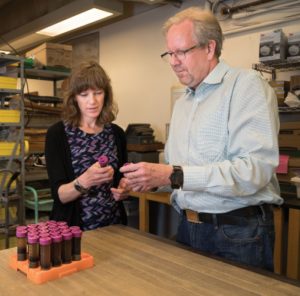
Can you dig it?: Soil Health Lab manager Kirsten Kurtz (left) in the lab with Harold van Es, professor of soil and crop sciences.Allison Usavage
Soil, on the other hand, is the stuff of life. Just ask Harold van Es, a veteran professor of soil and crop sciences who helped found the CALS lab in the mid-Aughts. “When you think about the basic resources that life on Earth depends on, they’re water, air, sun, and soil,” he says. “Soils provide the minerals and the medium for plants to grow—and ultimately we eat the plants, or we eat the animals that eat the plants.” And as van Es is pleased to report, soil is having its moment; the lowly matter beneath our feet is finally getting the respect it deserves. “Soil was misunderstood for a long time, but in the past few years, it’s been remarkable how much more people appreciate it,” says van Es, a native of Holland who has taught on the Hill for three decades. “People might have thought, ‘Soil is dirt, it doesn’t matter’—but I’ve seen a tremendous change in attitudes.” He attributes that shift, in large part, to the rise of the foodie movement, and the newfound obsession it has sparked regarding how and where ingredients are sourced. “If people care about food,” he says, “then they extrapolate relatively easily to, ‘Oh, then healthy soil is also important.’ ”
Last year, van Es and colleagues won a major award for their development of a method for helping growers establish optimal levels of nitrogen—a key ingredient in fertilizer—on their crops. Dubbed ADAPT-N, the cloud-based computational tool lets users enter information like planting dates, crop type, and tillage practices; it then uses weather records, detailed soil data, and more to identify the correct nitrogen levels, allowing growers to apply the minimum amount while optimizing yields. Now licensed by a major European fertilizer company, ADAPT-N beat out dozens of other entries to win the $1 million grand prize from the Tulane Nitrogen Reduction Challenge, established to find ways to reduce nitrogen runoff from farming—a major driver of the huge algae blooms in the Gulf of Mexico and elsewhere.
While ADAPT-N is a virtual tool, the Soil Health Lab’s work is decidedly hands-on, with a trained staff of technicians who process the thousands of samples it receives every year (predictably, spring is its busy season). Housed in Bradfield Hall—the hulking, mostly windowless brick tower at the edge of the Ag Quad—the lab is a pioneer in its field. The first facility to offer an exhaustive array of tests to assess soil health—Kurtz calls it “the most comprehensive soil health lab in the world”—it’s the busiest in the business, conducting some 50,000 individual tests per year. It has also set the standard for other such labs in the U.S. and abroad, as CALS staff have advised other institutions on getting their soil analysis programs off the ground. “We offer them our standard operating procedures—we’re an open book,” says Bob Schindelbeck, MS ’87, the lab’s director since its founding. That could mean specific guidelines (like drying particular types of samples for one day at 60 degrees Celsius) or common sense advice (like folding stacks of cone-shaped filter papers ahead of time for more efficient workflow). “We have great outreach,” says Schindelbeck, who also stresses the lab’s Cooperative Extension mission to help New York State growers. “It only makes us happier, because we believe it helps us do our job better.”
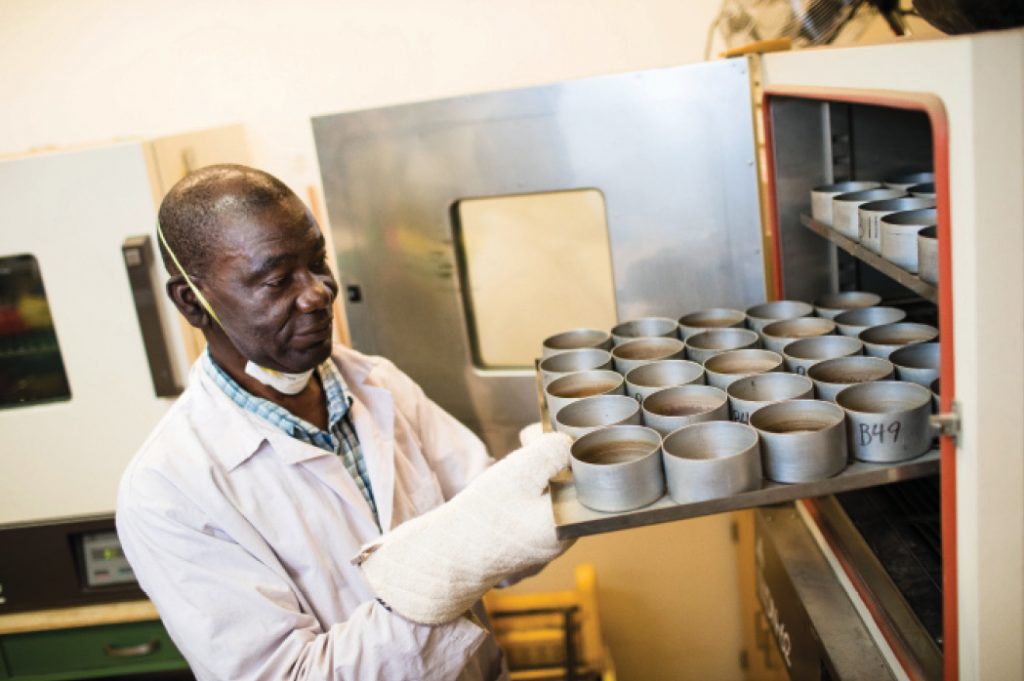
Lab technician Bamidaaye Sinon removes samples from the oven during a texture analysis.Allison Usavage
As he and van Es explain, in the past soil analysis mainly focused on its chemical components, such as the amount of nitrogen or its pH level—issues that could be addressed by the application of fertilizers and other additives. But in recent years, researchers have taken a more holistic look at soil composition. They now consider its biological elements—including the number of weed seeds or the presence of organisms like nematodes, which may be beneficial or harmful depending on the species. They also study its physical structure such as its texture, how porous it is, and the size of its crumb-like particles, known as “aggregates.” “We look at the chemical, physical, and biological aspects of soil, and we put them all together,” says Kurtz, “because soil processes influence each other.”
The lab’s clients include farmers, agribusiness consultants, landscapers, home gardeners, academic researchers, and the U.S. Department of Agriculture, which sends in samples from around the country to establish baselines for soil health. Its standard analysis package, a suite of sixteen tests, costs $110 and requires about four cups of soil, which clients mail in from throughout the U.S. and abroad. (The lab, which holds a USDA permit to import soil, follows strict safety protocols to prevent the spread of harmful organisms. Samples are autoclaved—heated to a high temperature—to kill any potential pathogens.) Van Es compares the tests—which can include a variety of add-ons, such as screening for heavy metals or measuring salt levels—to a person’s annual physical. “At your checkup, a number of measurements are made—your blood pressure, heart rate, cholesterol,” he says. “We’ve basically developed a holistic assessment of soil. If you see yields plateau, for example, you could put more chemicals into the soil—but there may be something else that’s limiting its function. You wouldn’t try to solve all your health problems through medication and not look at it in terms of lifestyle.”
Just as one weekend of sitting on the couch eating pizza and ice cream won’t send you to the ER but decades of it could have dire health consequences, season after season of using the wrong type of fertilizer, plowing when the ground is too wet, compacting the soil through the use of heavy machinery, or failing to rotate crops appropriately could lead to poor soil health and disappointing yields. “We’re giving guidance on where the primary problem is with your soil, and what strategies you should focus on,” says van Es. “It’s like saying, ‘If you eat better and exercise, you can build your health back up.’ ”
And, Schindelbeck says, at a time when the world is seeing more extreme weather events, soil health is more important than ever. “When you’re healthy, you’re sustainable,” he says. “Sure, an unhealthy person can walk up a flight of stairs—but what if you have to walk up sixty flights? If your soil is unhealthy, it’s going to really show in stressful environments, like this crazy weather we’ve been having. When there’s more drought, or it’s wetter for extended periods, healthier soil can take it without catastrophically failing.”
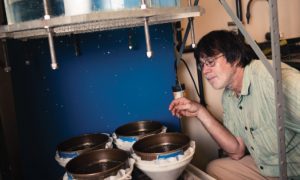
Lab director Bob Schindelbeck, MS ’87 with the “sprinkle infiltrometer” he designed.Allison Usavage
In the early Nineties, Schindelbeck designed one of the lab’s signature tests: a device, called a “sprinkle infiltrometer” that simulates rainfall. Essentially a vacuum-controlled water tank with tiny tubes along the bottom, it allows researchers to assess how well soil stands up to a deluge; does it wash away, or does it remain stable and retain the water as a resource for plant life? “We put the soil samples underneath and let the rain beat on them,” he explains. “It’s a five-minute thunderstorm.” The lab not only uses Schindelbeck’s creation in its own testing, but fabricates a field version for sale ($1,200 plus shipping) to other research facilities. As Schindelbeck describes how healthy soil behaves during a heavy rainfall—generating that clean, woodsy aroma that so many air fresheners aim to emulate—his language approaches the poetic. “As nature takes a drink, she exhales, and as that stale air is gone, the water percolates, pulling fresh air in—so she takes a breath,” he says. “Nature in her beauty not only takes a drink of water, she takes a drink of fresh air. That’s the rejuvenation of rain. What you smell in the rain is that exhale—it’s the soil’s breath.”
Earth Tones
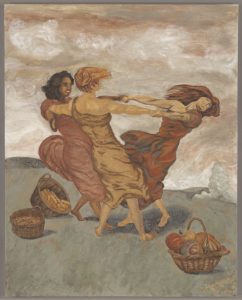
The award-winning Three Sisters in Soil
In Native American tradition, the “three sisters” are a trio of crops—corn, winter squash, and climbing beans—that thrive together, like supportive siblings. Last winter, Kirsten Kurtz, a formally trained artist who manages the Soil Health Lab, channeled that concept into a painting. Inspired by Franz von Stuck’s classic 1910 work Ringelreihen, it depicts three joyful women holding hands as they dance in a circle, their vegetables in wicker baskets at their feet. The four-by-five-foot image, created by Kurtz and five fellow artists during a public painting event in Mann Library in December, won first prize in a contest held by the United Nations’ Food and Agriculture Organization—and not just because of its theme. The painting, like all of Kurtz’s current artistic work, is executed in an unorthodox medium: soil.
Kurtz—who is also a master’s candidate in natural resources, conducting research on grassland soils in the Midwest—is among a small group of artists worldwide creating works whose pigments are derived entirely from soil. It’s an emerging genre that has ancient roots, stretching back millennia to paintings on cave walls. “Soil has become my preferred art form,” she says, adding that when it comes to conventional paints, “I couldn’t go back to the lack of texture, of depth.” Although she estimates that about ten other contemporary artists worldwide are currently painting with soil, she wasn’t aware of them when she started—so she had to develop her own technique. On her website, soilpainting.com, she shares step-by-step instructions: after the soil is air-dried and sieved, it’s mixed with water and clear gesso (a compound typically used to prime canvases) to form the consistency of acrylic paint. “I tweak my colors a lot, like I’ll mix a light sand in with a darker soil to get gray,” she says. “As I get more comfortable with this medium, I’m working with it almost like an oil painting where I’m blending on the canvas, which is really fun.”
While the majority of soils come in shades of black, brown, or red, there are some vivid exceptions, including a blue clay from Maryland (“I loved it so much, I’ve used it all,” Kurtz admits) and a green one from France. Kurtz notes that the medium requires patience and planning, since the paints tend to take on a lighter hue as they dry. “You have to build the colors up slowly,” explains Kurtz, who grew up on an organic farm in Upstate New York and studied visual arts as an undergrad at SUNY Empire State and Alfred University. “It takes at least five or six layers to get that richness and depth of color. Typically, I lay down a layer, walk away, and come back an hour or two later or the next day. I’ve learned the hard way that to match the colors again, I have to take really careful notes.”
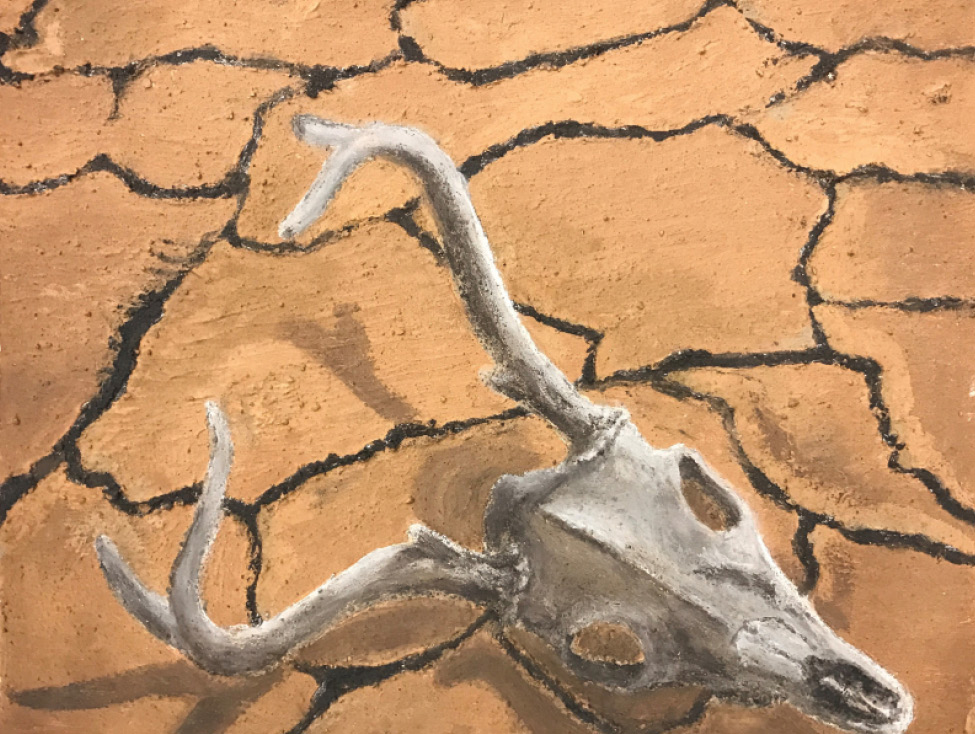
Kurtz’s After Artemis
For Kurtz, soil painting has not only offered the opportunity for artistic expression, but it has created a venue for outreach—a way to get people excited about soil, and to educate them about its importance. “I truly love soil,” she says. “I get really excited looking at it, thinking about where it’s from, how fertile it would be, what kind of minerals created its color. And I’m passionate about helping the public think about soil as a natural resource in the same way we think about air and water.” Kurtz has organized a variety of public soil painting events, which have drawn crowds of students, community members, and kids. (The latter, she recalls, “were playing with the soil, painting their faces with it—it was pretty adorable.”) A video of a 2015 celebration on campus to mark World Soil Day—at which participants created two large canvases, including a cutaway view of the geologic strata beneath McGraw Tower—inspired the U.N. to announce its worldwide soil painting competition. “That night,” Kurtz says with a laugh, “I bought the rights to soilpainting.com.”
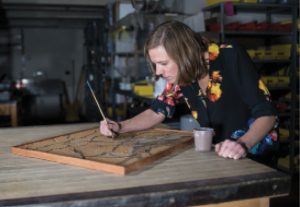
The artist at work on After Artemis
Asked to name soil’s main attraction as an artistic medium, Kurtz cites its rich, varied texture—but she points out that those same qualities can make painting with it a complicated endeavor. Not only is creating finely detailed lines a challenge—especially when working with soil that comprises large particles—but the final product can be much more fragile than a conventional work. “After we finished the Three Sisters mural, the clay all cracked,” she laments. “I had never worked with pure clay before, and I was pretty heartbroken.” She broke off all the cracked parts, added more gesso to the clay, and repainted it—but the same thing happened. “Then it occurred to me that I could also add soil to the clay, and lots more gesso, and I was able to get it to adhere,” she says. “The cracks in the different layers ended up being really cool, and I was even happier with the final product. It’s like science and art; it’s problem solving. You have to be creative.”



I guess I’m dating myself, but I had Dr. Scott for Agronomy 200 back in ’76. I was an entomology major, but Agronomy 200 with Dr. Scott was one of my favorite courses. And with apologies to Kirsten, we affectionally called it “Dirt”, although of course we knew better!
It sounds like the soil testing largely ignores the life in the soil. How can you assess soil completely after all the life in it has been killed?
One of the outstanding components of the Cornell Soil Health Assessment is that it includes the Biological indicators of Soil Organic Matter, Protein, Respiration and Active Carbon. The protocol simply calls for the soil to be aired dried so much of the life in the soil is left undisturbed. For more information you can view the fact sheets on individual indicators here: https://soilhealth.cals.cornell.edu/soil-health-manual-series/